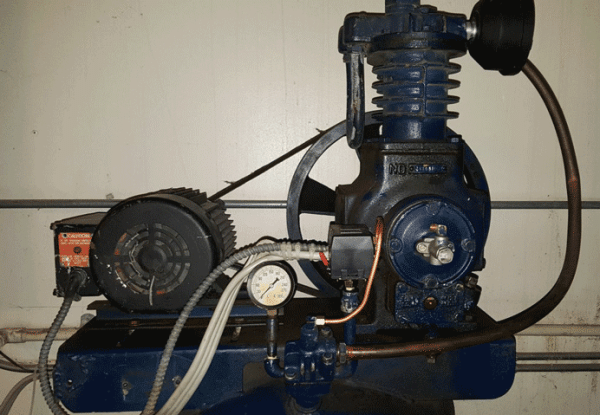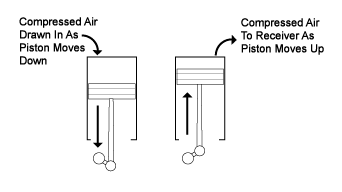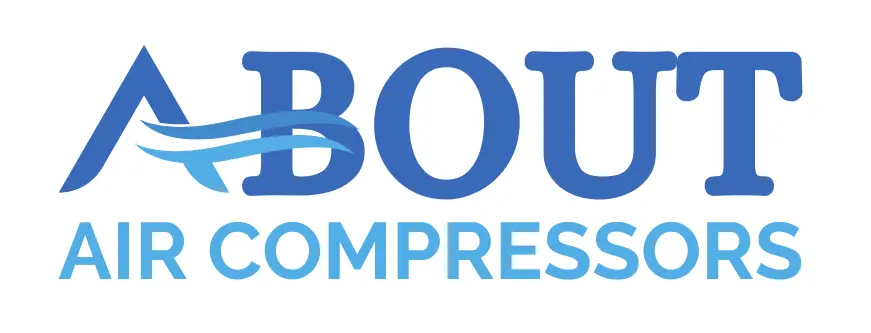Reciprocating air compressors are positive displacement piston-type air compressors that suck in air into a chamber and compress it. They do so by decreasing the area of the chamber and increasing the pressure in the air with the aid of a reciprocating piston.
This page will provide you with all the relevant information on reciprocating air compressors to help you better understand them, including how they work, different types, common uses, and top brands!
Table of Contents
- What Is a Reciprocating Compressor?
- Reciprocating Compressor Parts
- How Do Piston Compressors Work?
- Types of Reciprocating Compressor
- Reciprocating Air Compressor Uses
- Is a Reciprocating Air Compressor Right for You?
- Reciprocating Compressor Manufacturers & Where to Buy
- FAQs (Frequently Asked Questions)
- Other Types of Air Compressors
What Is a Reciprocating Compressor?
A dictionary defines the word reciprocate as the means to move something alternately back and forth. A typical reciprocating compressor for home or industrial use will contain one or more pistons in one or more cylinders.
Reciprocating compressors, also known as piston compressors, contain cylinders with one closed end and a piston that moves inside them. The cylinders are connected to valves that can be located underneath the compressor’s valve pockets. A vacuum of sorts is created during the initial stage of compressing the air, this is done by air moving into the cylinders via a suction valve which is initiated by the movement of the piston.
The piston inside the cylinder then reverses its motion, hence, the term reciprocating being used to describe them. This reciprocation starts the air compressing process, increasing the pressure within the cylinder. When the pressure has increased up to its design limit it then pushes the discharge valve open and allows the air to flow out of the cylinder and into the storage tank.

Reciprocating Compressor Parts
- Cylinder
- Piston
- Connection rod
- Crankshaft
- Suction valve
- Discharge valve
Cylinder
The chamber in which the piston moves back and forth allows the air to be compressed.
Piston
The reciprocating pistons create the air pressure in the system due to their reciprocating motion within the cylinder and are fully responsible for the compression of the air. These parts of the air compressor are under serious amounts of pressure when in motion and therefore require a very high-quality lubricant that is also free of contaminates.
Connection Rod
This is used to move the piston up and down inside the cylinder and they’re able to take a heavy workload. It is the connection between the piston and the crankshaft and they are often highly durable and therefore do not need replacing unless proper maintenance is not conducted on your air compressor frequently.
Crankshaft
The crankshaft plays an important part in transporting the rotary motion from the electric motor or diesel/gas engines to the connection.
Suction Valve
The suction valve provides the point in the air compressor where the air is brought into the device from the atmosphere. These valves require regular inspection and servicing.
Discharge Valve
The discharge valve allows for the air that has been compressed to flow out of the cylinder and in towards the storage tank.
How Do Piston Compressors Work?
There are 5 key aspects of the air compression processor in a reciprocating compressor that must be understood. As already mentioned, these compressors tend to draw power from a diesel or gas engine via a belt drive or direct-drive system. These systems will run continuously as long as the engine remains on. We will take a look at them briefly to gain a better understanding of the process as a whole.

The Intake Cycle
The first process of air compression is the intake cycle. This is where the piston is forced downward through the cylinder and reciprocates this motion. The motion itself provides a vacuum at the top of the piston and cylinder, this allows air of lower pressure to enter into the cylinder via a number of inlet valves that are located above the piston head as it moves downwards. The inlet valves remain open throughout this part of the cycle whilst the discharge valves are closed.
When the piston then moves back up the cylinder in its reciprocating motion, the inlet valves are forced into shutting so that all the air is trapped within the cylinder. The further the piston gets to the head of the cylinder the smaller the area that the air occupies, therefore, leading to pressurized air.
This air pressure then will exceed that of the air in the discharge valve causing it to open and allowing the pressurized air to exit the cylinder to an air receiver tank to smooth out any pulsations acquired during the compression process. This cycle then repeats itself over and over. Ensuring the discharge valve is closed blocks the air from moving back into the low-pressure section of the cylinder after it has been pressurized.
The Unloading Process
The pressure control/switch or sometimes referred to as the governor will sense that the air within the receiving tank has reached the threshold to cut out and will therefore initiate the air compressor to unload. The governor is typically mounted to the compressor and is the direct mechanism for unloading working to enforce specific amounts of intake and cut-out pressure.
This unloading of the air could be the full amount or even just partial amounts, it all depends on the design of each reciprocating compressor. Now that the air is compressed in the system, the pressure level is gradually reducing, and when it falls down to the pre-set load point a signal will be sent out by the control device to restart the whole compression cycle.
The Duty Cycle
The duty cycle is a very important air compressor basic to ensure you understand them. The duty cycle is essentially how much of a certain time period is the machine fully loaded/operating.
For instance, a 100% duty cycle in an 8-hour period would be the machine operating for 8 hours, whilst a 50% duty cycle would result in a 4-hour operating period. Reciprocating compressors are only designed for a 20 to 30% duty cycle and are unloaded or off the rest of the time. In comparison to rotary screw air compressors which operate at a 100% duty cycle.
It is very important to ensure that your compressor is not exceeding its duty cycle limits otherwise you will require maintenance early. The desire to maximize service life is very important, you do not want to push your compressor beyond its limits as it can be costly. Premature wear and component breakdown are certainly avoidable.
Lubrication
It is a possibility that in some but not all reciprocating air compressors the driving engine pump will share its lubrication with the compressor to keep the whole system functioning properly. This will require manual adjustments from those recommended by the supplier if you require accurate gauges of the reduced lubricant life expectancy as it is being used not only in the engine but the compressor too.
Cooling
Cooling methods in reciprocating compressors are very important to ensure the longevity of the compressed air system and its components. Without cooling methods in place, parts are more likely to wear and the danger of exceeding any temperature limits is of course apparent.
The lubrication also acts as the primary cooling source for most air compressor systems. It does so by being cooled in the engine oil cooler and then recycled through the compressor. This engine oil cooler can also eliminate small amounts of heat from the compressor body, removing it from the system along with discharged exhaust air.
Types of Reciprocating Compressor
- Single-acting
- Double-acting
- Diaphragm
- Single-stage
- Double-stage
Depending on the application of your air compressor, you have a number of type possibilities.
Single-Acting Piston Air Compressor
Single-acting reciprocating compressors only have a single side of the piston being used for the compression of air with the other side being connected to the crankshaft and not used for the compression. It is a very basic setup with one-way and spring-loaded inlet and discharge valves. For every turn in the crankshaft, one compression cycle is completed because the valves are only present at one end of the cylinder.
Double-Acting Piston Air Compressor
In this form of reciprocating air compressor, both sides of the piston are used for the compression of air. Suction and compression take place simultaneously on each stroke of the piston. These types of compressors have discharge and inlet valves and both ends of the cylinder, resulting in two compression cycles for every turn the crankshaft completes.
Double-acting air compressors tend to be extremely efficient, and thereafter are so prevalent within the manufacturing industry. They must operate at a high power which comes with a significantly large carbon footprint that of course, can not always be so practical.
It can be difficult to find one that operates at under 100 horsepower, and this tends to lead to a high level of vibration production. Therefore, careful consideration of the placement of the machine must be undertaken which could provide limitations.
Diaphragm Piston Air Compressor
Diaphragm compressors or otherwise known as membrane compressors, use a rotating membrane as such to pull air into their compression system. A diaphragm reciprocating compressor makes use of hydraulic and air pressure systems with a protective flexible metal diaphragm barrier between them. They are most commonly used to compress toxic or explosive gases rather than just air.
Single Stage Piston Air Compressor
A single-stage reciprocating air compressor uses just a single cylinder. In the first stroke of the piston, the air is sucked in from the atmosphere and then in the second, the air is compressed and delivered to the compressor storage tank. They are most commonly suited to powering handheld pneumatic tools that require less than 100 psi of pressure.
Double Stage Piston Air Compressor
Double-stage compressors, otherwise referred to as multistage reciprocating compressors, work in a similar fashion to the single-stage however, it does not make their way to the compressor storage tank after their first compression. Instead, it goes through a second stroke in a smaller piston to be compressed again for additional pressure.
Once the air has been compressed and pressurized twice, it is then put through the cooling system and sent to the compressor storage tank. Double-stage compressors are typically found in large industrial applications as they can produce significantly more air power than other types.
Reciprocating Air Compressor Uses
A reciprocating air compressor is best suited for all sizes of businesses and industries. Not only that, but they’re very popular within everyday applications which most people may not realize. In your home, your refrigerator and freezer use an air compressor to cool air within their units and if you have an air conditioner, they also use them as their main source of power for the cooling of your rooms.
The most common industries that utilize air compression are construction, manufacturing, agriculture, the energy sector, and HVAC (heating, ventilation, and air conditioning). Some surprising uses of compressed air can be found in daily life that you may not have otherwise realized, these are in carpentry & furniture, pressure washing, crafting, pumping inflatables, and yard work.
Some recreational activities also make use of air compression like paintballing, scuba diving, and even within birthday parties for bouncy castles. But to switch the focus back to more business and industrial-related uses, we will first take a look at small businesses.
Small Businesses
The following uses for air compressors are just a few of many applications within small businesses:
- Dental tools
- Medical tools
- Sandblasters within factories or plants
- Snow manufacturing for skiing/snowboarding
- Pneumatic drills, nail guns, and hammers
- Air guns for cleaning machinery within factories or plants
- Spray painting for vehicles
- Wood or auto-body sanding
Agricultural
The agricultural industry commonly uses air compressors for a variety of needs, some of these are:
- Conveyors moving grains between the silos and other destinations
- Spraying the crops with pesticides or fertilizer
- Powering varying types of material handling machinery
- Ventilation systems in massive greenhouses
- Powering different types of dairy machines from milking to transportation
Large Manufacturing Businesses
Air compressors can be found in large manufacturing businesses whether that be for fabrication, assembling parts, refinery, or other plants. It is an essential source to power this massive operation. Some notable uses are:
- Cutting equipment
- Welding equipment
- Air tools and automated machines
- Component ejection from molds
- Molding gas tanks and plastic bottles
- Production monitoring devices
- Pneumatic finishing and packaging devices
- Positioners, air knives, clamps, and chucks
Is a Reciprocating Air Compressor Right for You?
If you are in the market for an air compressor of any sort, spending time examining the huge variety and styles of compressors may not be productive if you do not know the answers to the following questions:
- What is the flow rate you need for your air tools or to run your plant, now and for potential future expansion?
- At what air pressure do you need that flow?
Having the answers to these questions upfront will help narrow the range of air compressors you need to look at. And then you will look for units with the following characteristics:
- A compressor that fit your budget
- One that fits into the area where you would like to install it
- Perhaps a compressor with the lowest up-front cost
- Or a style that has the lowest maintenance/operating costs
- You may want a very quiet compressor
- Or one that provides ultra-clean or breathable air
Once you have determined the parameters of your compressor needs, then you will be pointed in the right direction for the right kind of air compressor.
Reciprocating Compressor Manufacturers & Where to Buy
- Atlas Copco Air Compressors
- Campbell Hausfeld Air Compressors
- Quincy Air Compressors
- United States Air Compressor Company
Some of the top piston compressor manufacturers in the reciprocating compressor market are those listed above. You’re certainly not limited to these brands, as the majority of air compressor manufacturers will likely have reciprocating compressors in their catalog.
If you’re looking to buy, I recommend visiting the brand’s website and contacting them directly for more information on their products. Otherwise, you can conduct thorough searches through e-commerce sites like Compressor World, or Amazon. Here’s an example of a piston compressor available on Amazon.
Quincy offers this 60-gallon reciprocating air compressor that has a working pressure of 145-175 PSI.
- Industrial-duty US-made Baldor motor
Prices pulled from the Amazon Product Advertising API on:
Product prices and availability are accurate as of the date/time indicated and are subject to change. Any price and availability information displayed on [relevant Amazon Site(s), as applicable] at the time of purchase will apply to the purchase of this product.
FAQs (Frequently Asked Questions)
Reciprocating compressors are used across small and large manufacturing businesses, along with everyday applications. The most common industries that utilize piston compressors are construction, manufacturing, agriculture, the energy sector, and HVAC (heating, ventilation, and air conditioning).
A reciprocating air compressor uses piston-driven crankshafts to pressurize air, increasing its density while decreasing its volume to increase pressure. A reciprocating compressor uses pistons to compress air. There is a central crankshaft that drives anywhere from two to six pistons inside cylinders to compress the air ready for storage in the tank.
The reciprocating compressor is a type of compressor in which the compression of the gas is achieved by piston strokes. There are various types of reciprocating compressors available, these are single-acting, double-acting, diaphragm, single-stage, and double-stage (or multi-stage).
The key difference is their design and working principle. Reciprocating compressors use pistons that move up and down to compress the air inside the cylinder. While rotary compressors have two screws that turn in opposite directions, trapping the air between them and causing compression. Rotary compressors are known to replace reciprocating compressors where high pressures are a requirement.
Other Types of Air Compressors
If you’re interested in finding out more information on other types of air compressors please visit our specific pages:
- Rotary Screw Compressors Explained
- Rotary Vane Compressors Explained
- Centrifugal Compressors Explained
- Axial Flow Compressors Explained
- Scroll Air Compressors Explained
- Oilless Air Compressors vs. Oil Compressors
If you have any questions regarding reciprocating air compressors, please leave a comment below with any photos if applicable so that someone may help you!
